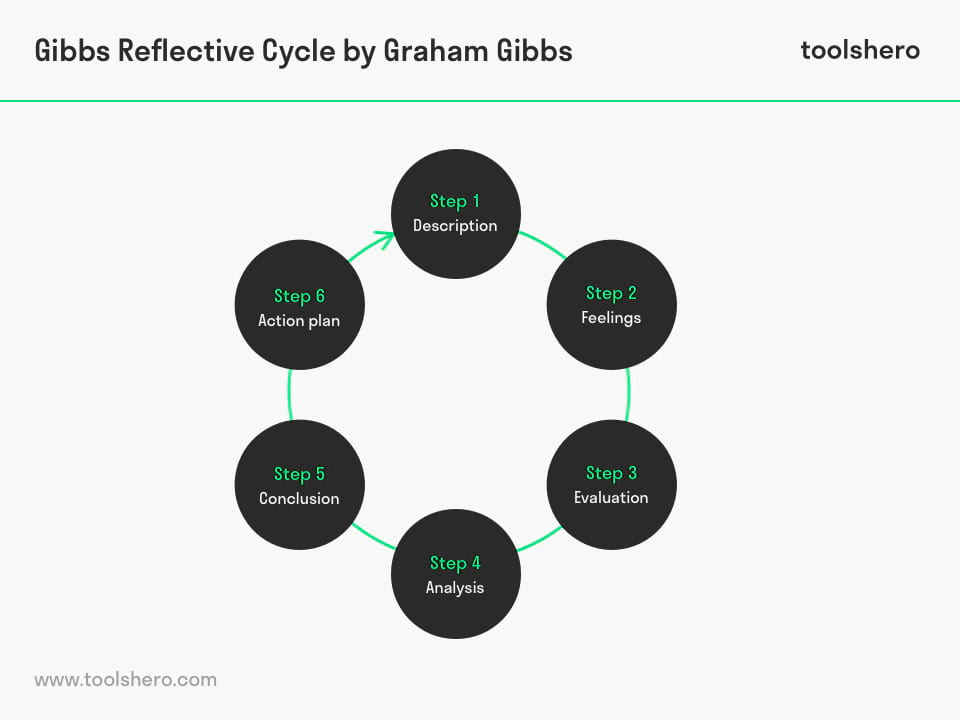Gibbs Reflective Cycle: Theory and Example Template

Gibbs Reflective Cycle: this article explains the Gibbs Reflective Cycle by Graham Gibbs in a practical way. Next to what it is, this arfticle also highlights the steps of the Reflective Cycle, the realtionship with experiences and a downloadable and editable Gibbs Reflective Cycle example template to get started yourself. After reading it, you understand the core of this management and self-reflection tool. Enjoy Reading!
What is the Gibbs Reflective Cycle?
In 1988, the American sociologist and psychologist Graham Gibbs published his Reflective Cycle model in his book ‘Learning by Doing‘. Gibbs Reflective Cycle encourages people to think systematically about the experiences they had during a specific situation, event or activity.
Using a circle, reflection on those experiences can be structured in phases. This often makes people think about an experience, activity or event in more detail, making them aware of their own actions and better able to adjust and change their behaviour.
By looking at both negative and positive impacts of the event, people can learn from it.
The Gibbs reflective cycle itself
The Gibbs Reflective Cycle starts at Description and then continues clockwise to Feelings, Evaluation, Analysis, Conclusion and ends at Action plan, to finally return to Description. Here the Gibbs reflective cycle is complete.

Figure 1 – the steps of the Gibbs Reflective Cycle
The various steps are explained in more detail below:
Step 1: Description
During this step, you describe the situation, event or activity in detail, without drawing any conclusions right away. The most common questions that can help create an objective description are:
- What happened?
- When did it happen?
- Where did it happen?
- Who were involved?
- What did you do yourself?
- What did other people do?
- What was the result of these actions?
It should be noted that important details must not be left out. For instance, why other people were involved in the situation in question. All information that is key to better understanding the situation is relevant.
Step 2: Feelings
This phase is about the feelings that the event triggered, as well as what someone’s thoughts were during the event, activity or situation described in step 1. The intention is not to discuss the feeling in detail or comment on it directly. Emotions don’t need to be evaluated or judged. Awareness is the most important goal of this phase. Helpful questions that are often used:
- What did you feel leading up to the event?
- What did you feel during the event?
- What did you feel after the event?
- How do you look back on the situation?
- What do you think other people felt during event?
- How do you think others feel about the event now?
Because people often have difficulty talking about their feelings, it helps that they’re encouraged by the questions or someone asking these questions.
This also demonstrates that the Gibbs Reflective Cycle can be used in an individual setting, or even in a coaching or counselling setting. The final two questions also allow one to see the event from other peoples’ perspectives.
Step 3: Evaluation
In this step, you ask yourself whether the experience of the event in step 1 was good or bad. Which approach worked well and in what way? Which approach didn’t work as well? It can be difficult for people to be objective about the situation. In order to still conduct a proper evaluation, the following questions may be helpful:
- What went well during the event or activity?
- Why was that?
- What didn’t go so well?
- Why was that?
- What was your contribution?
- What contribution did other people make?
It is also worth evaluating bad experiences, because the subsequent steps in the Gibbs Reflective Cycle help people learn from it.
Step 4: Analysis
This phase is about what you have learned from the situation, event or activity. Because of the experience, you now know what to do in similar, future situations.
This means that both positive and negative things and/or problems you experienced will be written down and analysed individually. After all, people learn from mistakes. This analysis is often done together alongside step 3.
Step 5: Conclusion
This is the step where you take a step back and look at yourself from a distance and ask what else you could have done in this situation. The information gathered earlier is very valuable in this step and can encourage you to come to a good and useful conclusion. The following questions may be helpful:
- To what positive experience did the event, situation or activity lead?
- To what negative experience did the event, situation or activity lead?
- What will you do differently if the event, situation or activity were to happen again in the future?
- Which skills do you need to develop yourself in a similar event, situation or activity?
Step 6: Action plan
In this final step, actions are developed for future situations, events or activities. Based on the ‘Conclusions’ in the 5th step, people make concrete promises to themselves. The intention is to keep these promises. If everything went well, you can promise yourself to act the same way next time.
In areas where things didn’t go so well, you can promise yourself not to make the same mistakes again. What will be a more effective approach and which change will lead to actual improvement?
In addition to an action plan, it’s wise to also make a plan on how to encourage yourself to stick to these promises.
Experiences
Thinking about one’s own experience can help to perform better or do things differently in the future. As the above shows, these experiences don’t have to be positive; negative experiences are also useful.
Next time a similar situation presents itself, you’ll know it’s better to approach the situation in a different way. It stimulates you to think long and hard about how to do things better next time. This is what Gibbs Reflective Cycle is all about.
People don’t just learn to understand certain situations better, but also learn to judge how the same situation can be handled in different ways in the future.
Gibbs reflective cycle: How to use it
Gibbs Reflective Cycle can be used in a variety of ways. First of all, any individual can use the cycle. If you’re open to actively changing yourself, the Reflective Cycle can be a helpful tool.
Coaches also use the Cycle to make their coaches aware of (unwanted) behaviour and find ways together for the coach to react differently to a situation.
In addition, the Reflective Cycle is often used in higher education. Especially when carrying out internship assignments, the cycle can be a good tool to make an intern aware of his or her actions. The part about how you’ll handle a similar situation differently in the future is specifically aimed at reflecting on one’s own actions.
After all, at the end of an internship period an intern should have developed him / herself enough to carry out internship assignments independently and behave professionally.
Gibbs Reflective Cycle template
Start reflecting on your experiences and actions with this editable Gibbs Reflecting Cycle template.
Download the Gibbs Reflecting Cycle template
This template is exclusively for our paying Toolshero members. Click here to see if a membership is something for you!Now it is your turn
What do you think? What are your experiences with the Gibbs Reflective Cycle. How do you encourage people to think systematically about past experiences? Are you already using the Gibbs Reflective Cycle and do you have tips and tricks, or would you like to add anything?
Share your experience and knowledge in the comments box below.
More information
- Finlay, L. (2008). Reflecting on reflective practice. PBPL paper, 52, 1-27.
- Gibbs, G. (1988). Learning by Doing: A Guide to Teaching and Learning Methods. Oxford: Oxford Further Education Unit
- Gibbs, G. (1998). Reviewing and improving your teaching. Practice Guide, 7, H851.
How to cite this article:
Mulder, P. (2018). Gibbs Reflective Cycle. Retrieved [insert date] from Toolshero: https://www.toolshero.com/management/gibbs-reflective-cycle-graham-gibbs/
Original publication date: 02/28/2018 | Last update: 11/30/2023
Add a link to this page on your website:
<a href=”https://www.toolshero.com/management/gibbs-reflective-cycle-graham-gibbs/”>Toolshero: Gibbs Reflective Cycle</a>













One response to “Gibbs Reflective Cycle: Theory and Example Template”
This item was so useful. Thanks for the article